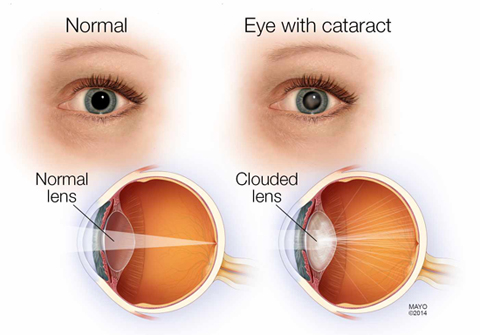Cataract Surgery
How can a cataract be treated?
A cataract may not need to be treated if your vision is only slightly blurry.
Simply changing your eyeglass prescription may help to improve your vision for a while.
There are no medications, eye drops, exercises, dietary supplements or glasses that will cause cataracts to disappear or stop progressing or to prevent them from forming.
Surgery is the only way to remove a cataract. When you are no longer able to see well enough to do the things you like to do, cataract surgery should be considered. In cataract surgery, the cloudy lens is removed from the eye through a surgical incision. In most cases, the natural lens is replaced with a permanent intraocular lens (IOL) implant.

When should surgery be done?
Surgery should be considered when cataracts cause enough
loss of vision to interfere with your daily activities. It
is not true that cataracts need to be ‘ripe’ or ‘mature’
before they can be removed or that they need to be removed
just because they are present. Based on your symptoms, you
and your ophthalmologist should decide together when surgery
is appropriate.
Will cataract surgery improve my vision?
The success rate of cataract surgery is excellent, over
95%. However, even if cataract surgery is successful, some
patients may not see as well as they would like to. Other
eye problems such macular degeneration, glaucoma or diabetic
retinopathy, if present, may limit vision after surgery.
Even with these problems, cataract surgery may still be
worthwhile. Talk to your ophthalmologist to learn more about
cataract surgery, its risks and benefits.
What can I expect in cataract surgery?
During cataract surgery, which is usually performed
under local or topical anesthesia as an outpatient
procedure, the cloudy lens is removed from the eye. In most
cases, the focusing power of the natural lens is restored by
replacing it with a permanent IOL implant. Your
ophthalmologist performs this delicate surgery using a
microscope, miniature instruments and other modern
technology. Hence, traditionally, this procedure is often
referred to as ‘microsurgery’.
Nowadays cataract surgery is performed by a technique
called phacoemulsification.



